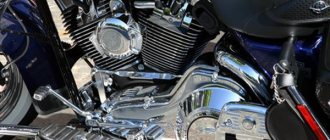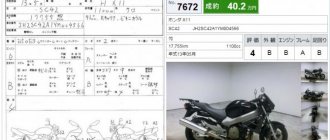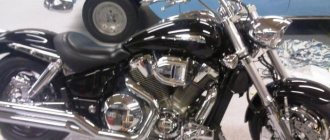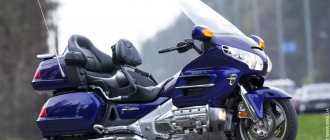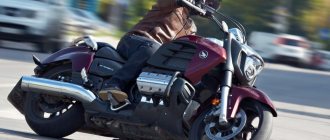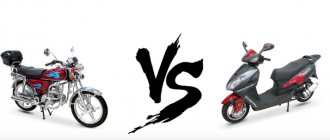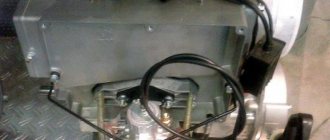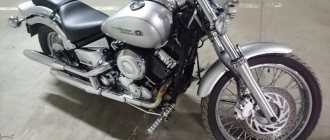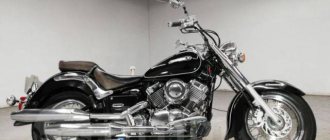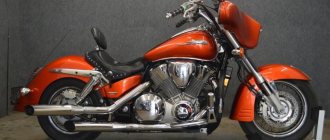First acquaintance with Yamaha xvs 400
Confirming the favorite phrase of the “dirt mixers”: “Everyone will ride enduro!”, After a break in service, I began my motorcycle life with enduro. But I want to drive not only through the forest, so the choice was between a chopper and a chopper. Sports are only suitable for track use, long-distance travel is not an option for me, so the choice is obvious: Yamaha drag star 400. Why exactly “scabies”!? Everything is simple here: the difference is in price, and there is no difference in appearance. From the outside, “Draga” is practically no different from its liter counterpart, and it has no less pathos and style.
In the midst of the unbridled chrome bacchanalia in the salon where I chose a motorcycle, the Yamaha xvs 400 drag star classic version was in no way inferior to its neighbors. Among all the 400-acre buildings, it was the most “serious” and largest. Being 170 cm tall, I felt absolutely no discomfort during the test drive. I liked its brother in the line, the Yamaha drag star 400 custom, with short wings, less, despite its lighter weight. In general, Dragstar has been produced since 1996 in three main versions: Classic, Custom and the V-Star model for the American market.
There is no need to be afraid of the drag; it steers easily both in the city and on the highway, largely due to its low center of gravity. Handling is a solid four. The feeling of reliability that appeared from the first moments of the trip has not left me to this day. Thanks to the low seating position, the Yamaha drag star 400 classic easily turns into corners at the most incredible angles, and just as easily goes straight out.
Well, the appearance, of course, is beyond praise - the Japanese know how to play on our weaknesses. High steering wheel, wide tank, elegant dashboard right on the tank, fenders like an old Indiana - deep and simply luxurious. The footpegs are set far forward. The brake lever is located very conveniently – right under the heel. The first days you adapt to not press it accidentally, then you find a comfortable position for your foot and forget about it.
Fluke
My initial desire was a Honda VTX 1300 or a Royal Star - Yamaha XVZ1300. After reading forums and reviews from owners, and listening to my wife’s sighs, I decided to consider other options. A month of online and live communication with chopper owners led me to a choice: a Honda BTX 1800 or a stylish Yamaha XB 1900.
We also recommend that you read the review of the Honda Shadow 400.
The availability of both options on the secondary market in our city left much to be desired. It is clear that you will have to order through sempermoto from Japan or America, so there was not much difference, 1800 or 1900. I didn’t have much experience riding Yamahas, but I knew Hondas very well, but I was more drawn to the unknown. The agony of choice disappeared by itself when my beloved called and said that she had agreed to test drive a Honda vtx 1800 motorcycle in the store.
An unexpected weakness arose inside me when they rolled Vtyks onto the site. A small tremor passed through the palms, and, penetrating the whole body, went into the shoes. Even before I had ridden him, I realized that it was He.
I still remember my first trip, although 4 years have passed. The Honda vtx 1800 seemed to be testing my strength - it was big and heavy, it took turns awkwardly, making me blush under the sealant and sweat in the aisle, where, out of habit, I still drove a couple of times. It was love at one sight, the condition of the bike turned out to be perfect, but the price did not suit me. At home, in the evening, my wife and I discussed loan options for the missing amount, but then a call came from Yekaterinburg - a buyer had been found for Shadik. Fate itself was on our side. Sorry Yamaha xv, see you later!
The formalities are over, the Honda vtx 1800 is in my garage, the technical specifications have already been memorized, the routes for long runs have been laid out, we are waiting for spring, we are rolling in little by little.
Yamaha drag star xvs 400: some technical details
The Yamaha drag star xvs 400 is considered the successor to the Virago, but, of course, a lot of work has been done on this model. The result is a stylish cruiser with an updated carburetor, new brakes, rear mono suspension and a duplex frame. It is somewhat unusual for the designers to introduce a cardan transmission instead of the usual chain, but, be that as it may, since 1996, the motorcycle still has a huge army of fans.
Characteristics of the Yamaha drag star 400: reliable V-shaped engine with 32 horses, classic five-speed gearbox. It took me a long time to get used to the operation of the gearbox - I spent a long time looking for neutral, the range of motion is very large, and you have to switch sharply, with a certain amount of force. Similar box operation is a feature of all Yamahas. Acceleration to hundreds takes about 6 seconds. Perhaps the only thing that doesn’t particularly suit me about Draghi is a strange property: the higher the speed, the more difficult it is to gain momentum. This factor constantly interferes with overtaking, it seems like the gas is on full throttle, but the speed increases slowly. Partially, the torque is pulled by the cardan; I would still like the motor to be more powerful.
Reading reviews about the Yamaha drag star 400, I often came across information about gasoline consumption of more than five liters on the highway. The consumption of my motorcycle over the years: in the city is 4 liters, on the highway a maximum of 5 liters. And this is at my average speed of 100 - 120 km/h. Although my Yamaha drag star 400 technical characteristics do not differ from the standard ones.
Yamaha XVS 400 DragStar, classic models are equipped with a two-cylinder, four-stroke, air-cooled engine. I can say one thing about cooling: no matter how much they frighten me that due to traffic jams it will not be enough for normal engine operation, Draga has never let me down. Although sometimes you have to crawl in traffic jams. My motorcycle weighs 226 kg and the tank holds 15 liters. The brakes of the Yamaha drag star 400 are quite reliable. The cardan, like the engine, is eternal. All that can and should be done with it is to change the oil at the beginning of the season.
On our website you can also read a review of the Honda Steed 400 - this model is legendary in its own way and continues to be in great demand.
There are no complaints about the front suspension, but the rear is quite capricious, which is understandable: the Japanese did not count on our “roads”. An attempt to tighten the shock absorber more strongly failed: it is too rigid, if you loosen it further, it becomes scary at every little hole, the shock absorber hits so hard. After much experimentation, a golden mean was finally found. Although for long trips with the second number and the “shmurdyak” you have to tighten it up a bit.
Technical specifications and my impressions
To say that I am delighted with Honda is to convey only half the emotions. In the bustle of the city, its dimensions take its toll; traffic jams allow you to feel its weight again and again. The low center of gravity helps, and envious glances from cars cause euphoria. Still, the technical characteristics of the Honda vtx 1800 place it in the category of conquerors of country roads and long roads, and not trips between cafes.
What earned this device the title of king of the tracks - of course, these are unique capabilities, characteristics and features for the Honda vtx 1800. As soon as you leave the city limits, Vtyks wakes up. It holds the road like a glove, swallowing small bumps, accelerates to hundreds in three seconds - the power of 107 horses makes an impact. The first country trips confirmed the opinion about low vibrations and smoothness, even before purchasing, reading opinions and reviews of owners on the Honda VTX 1800, I noticed that the VTX V-twin was compared with the V4 from the Yamaha Royal Star 1300. Large engine (torque value – 156 Nm) and short five gears help out when overtaking. Without even noticing it, you can accelerate to 200 km/h. Further acceleration is accompanied by a loss of dynamics. My maximum is 230 km/h.
Even before purchasing, while studying opinions and reviews on the Internet about the Honda vtx 1800, I noticed that some were missing five gears. Apparently, I’m so used to my motorcycle that I’m happy with everything about it. I’ll tell you separately about the brake system. The deceleration dynamics are simply amazing. Front discs are 296 mm, rear discs are 316 mm and a combined brake is synonymous with reliability that never leaves you on the road. When driving fast, the braking distance increases significantly, which is affected by the motorcycle's own weight - 360 kilograms plus equipment, driver and passenger. The total is almost 500 kg. That's why I don't often drive more than 140 km/h. Even an ideal standard braking system is not able to stop half a ton at high speed. The very first tuning on my Vtykx was reinforced hoses.
The entire ergonomics of the cruiser is designed to protect the driver from the flow of oncoming air. Despite this, at speeds of more than 120 km/h, you want more comfort, especially when you are wearing an open helmet. Therefore, on my Honda vtx 1800, all tuning was not limited to hoses - before traveling to Baikal, I installed a windshield and changed the panniers. The standard exhaust sounds solid, moderately loud and melodic. I don’t see any point in converting to direct flow yet.
Among other features, the technical characteristics of the Honda vtx 1800 provided fairly decent ground clearance for a heavy chopper. When traveling I had to travel along a completely unimportant road, in Altai, for example. The crankcase is limited by the frame and is quite protected - in order to break it or roll it, you need to really try. I think you shouldn’t confuse a cruiser with an enduro, then you’ll be able to handle almost any road and bring you only joy.
Comparing my actual consumption on the Honda VTX 1800 and online reviews, I understand that I was lucky. Moving from a hundred to a hundred and twenty, the engine burns no more than 7 liters. While the average is from 7 to 8 liters. High speed leads to an increase in consumption by approximately one liter for every 10 km/h. I prefer to refuel with 95-octane gasoline: it drives much easier and faster, fuel is consumed 15% more economically.
VTH became my continuation. Having gotten used to it, tried all the possibilities, understood the features of control in various conditions and felt all its power, you understand that you won’t be able to “vomit” on it and you don’t want to. I did not describe in detail the technical specifications of my Honda vtx 1800 here; they can be read on the Internet. By focusing on my own feelings, I hope to help someone with their choice, and remind once again that they should not be afraid of “large” sizes.
Yamaha drag star xvs 400: care and maintenance
Yamaha drag star xvs 400 is unpretentious in care and maintenance. It will serve you faithfully for many years if you change all consumables in a timely manner and service the “old lady” on time. When hands grow from the right place, even a girl can handle basic operations. Moreover, judging by the reviews, the Yamaha xvs 400 drag star classic is serviced similarly to its classmates and more powerful versions. With your own hands you can:
- clean and synchronize carbs;
- replace the air and gasoline filters;
- change the oil and oil filter in the engine;
- transmission fluid in the gearbox;
- brake fluid.
In addition to these mandatory operations, during the entire period of ownership, the seals on the fork and the bearings on the steering column were changed twice. By the way, I haven’t done any tuning for my Yamaha drag star 400 and I don’t plan to yet. It makes no sense to describe the synchronization of carburetors - here you need to watch the video. There are a lot of videos on the Internet on this topic, but here you can tell how to change the filter and “fluids”.
Oil. Changing the oil is a simple operation and can be done without outside help. Let's prepare replacement oil and a new filter. You should not skimp on the filter, because all the dirt collected over the kilometers traveled remains in it. The oil and filter are changed every 15,000 kilometers or at the beginning of the season (if you drive a little). On the Yamaha xvs 400 drag star classic, according to many opinions, any semi-synthetic is suitable: 10W40 or 15W50.
Warm up the engine, unscrew the drain bolt on the left side and wait until everything drains. If the oil is too “scary” for various reasons, you can pre-rinse it: i.e. first fill in another, cheaper oil. To replace, we dismantle the pipe, then the pedal assembly on the right side. Carefully fold all the parts and rubber gaskets. If you are changing the oil for the first time in your life, it makes sense to write down the procedure, no matter how funny it may sound.
Replacing transmission fluid in the gearbox of either the Classic or the Yamaha drag star 400 custom is not difficult, however, just like on other choppers. Just like with the engine, first let’s warm up the oil a little - you can just drive around the yard. We unscrew the upper and lower maintenance bolts and drain all the liquid to the last drop. Tighten the bottom bolt and pour fresh oil through the top hole. We simply fill it under the cap if we are too lazy to read the service documentation or it simply isn’t there. If there is more oil than needed, it’s not a big deal. Excess fluid will come out through the breather hole.
Brake fluid. Replacing or adding brake fluid on a Yamaha drag star 400 classic: to do this you need to know the brand of what is already filled or be sure to flush the system. The thing is, Dot-3 is radically different from Dot-5 and others, regardless of the manufacturer. If you mix different liquids you can get the saddest result. Therefore, using a couple of hundred milliliters of new brake fluid, we flush the system and only after that we finally fill it with fresh one.
Gasoline filter. With our quality of gasoline and the cheap price of a gas filter, I prefer to change it several times a season (and our season in the south lasts 10 months). The filter itself is located under the seat, and even a child can remove it. In the auto shop we select any one that is suitable in shape and size and put it in place of the old one.
Air filter. Replacing the air vent on Drage is the simplest operation. It's even faster than filling up. There is a round cover on the right side. Mine is chrome. We remove the cover by unscrewing the three hex bolts, take out the old filter and put a new one in its place. We tighten the bolts. All is ready.
About consumables. As a rule, all original liquids and consumables cost one and a half to two times more expensive than non-original ones. Judging by my experience and taking into account reviews of the Yamaha drag star 400, original spare parts are no different from non-original ones. Therefore, I don’t see the point in overpaying.
Yamaha drag star 400: Recommendations for future owners
Why would I recommend a four-hundredth for beginners or as a second motorcycle? The Yamaha drag star 400, the technical characteristics of which I described above, has normal dynamics, guarantees comfortable movement without surprises and economical fuel consumption. The maximum speed of 140 km/h is enough for the eyes. Unpretentious in care and maintenance, reliable cardan, and, of course, an external “adult” appearance for little money. For healthier drivers, it's worth taking a closer look at the classic model. For those who are lighter in weight and height, the Yamaha xvs 400 drag star custom model is more suitable. But in general, decide for yourself, and always take what resonates with you at first sight.
Specifications
| Maximum engine power: | 33 HP |
| Torque: | 32 Nm |
| Working volume: | 399 cm3 |
| Motor type (cylinder arrangement, number of strokes): | 2-cylinder, 4-stroke, V-shaped |
| Number of cylinders: | 2 |
| Number of valves: | |
| Intake type (Injector / Carburetor): | |
| Bore and stroke: | |
| Starting system (Electric starter, kick starter): | |
| Maximum speed in km/h: | 135 km/h |
| Cooling system: | Air |
| Transmission (gearbox): | 5 |
| Clutch (Dry / Wet): | |
| Drive unit: | Cardan |
| Frame: | Steel duplex |
| Chassis | |
| Suspension (front/rear travel): | |
| Brakes (Front/Rear): | |
| Wheels / Tires / Rubber: | |
| Dimensions and weight | |
| Dimensions (Length / Width): | |
| Seat height: | |
| Ground clearance: | |
| Curb weight: | |
| Wheelbase: | 1610 mm |
| Weight: | 225 kg |
| Fuel tank capacity: | 16 l. |
| Battery capacity: | |
| Year of release: | |
| Country of Origin: |
Release Features
Model Suzuki Boulevard C90T.
Model Suzuki Boulevard C90 BOSS
Based on the American version, they create a modification C90T . The letter stands for "tourist". The stock package adds side panniers (leather!!!), a high windshield, and also changes the saddle.
In 2012, a decision was made to curtail further production of the version for European countries. The American one receives another update a year later. In the Suzuki Boulevard C90 BOSS . (as the American began to be called), the motorcycle gets new wheels, brakes, a more powerful engine and an enlarged (up to 18 liters) fuel tank.
The tourist is also assembled on the basis of the new model, but its equipment does not change . More comfortable saddle, windshield, suitcases.
High windshield.
Comfortable separate seats.
Leather side case.
It is curious that the model includes only side cases . There is no back one. However, some versions have a backrest for the second number (and sometimes for the driver). Because of its design, you have to decide - either it or the trunk. The motorcycle does not have a special trunk. Boulevard production continues as before, although most of the bikes are exported to North America.
